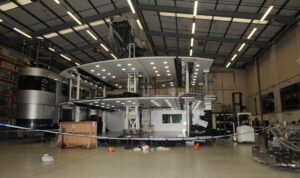Regulator’s report on “forever chemicals” published
A report published on Tuesday 4 April has set out in detail the extent to which so-called “forever chemicals” are used in Great Britain.
It has analysed how “forever chemicals” or PFAS (Poly- and perfluoroalkyl substances) are used. The report has also included exposure from everyday items such as food wrappers, cleaning products, and furniture coatings.
PFAS are pollutants that are slow to degrade. They are often called “forever chemicals” because they do not naturally breakdown and can stay in the environment for decades.
In the most comprehensive British analysis of these chemicals ever, the Health and Safety Executive (HSE) has identified the most common and most harmful uses of PFAS and what measures could be put in place to control and manage them.
The HSE report makes a number of recommendations including to limit the use of PFAS-containing foams used by firefighters to put out fires, as well as the use of PFAS in textiles, furniture, and cleaning products.
It has been published under UK REACH, the framework for managing the risks from chemical substances in Great Britain. HSE, the regulator for UK REACH, has worked with the Environment Agency.
Dr Richard Daniels, director of HSE’s chemicals regulation division, said: “PFAS are a global issue of concern. We have looked at responses around the world, but it was vital we gathered the right information and evidence on how PFAS are used in Britain specifically.
“This has helped us work out where the right action could be taken to limit the use of PFAS and control exposures to people and the environment in this country.
“The reality is that PFAS substances, due to their persistent properties, will continue to be detected for many years – despite measures being taken to limit restrict or ban their use.
“We will now look at the availability and risks posed by alternatives to ensure maximum long-term protections can be gained.”
One of the key proposals is that, due to more comprehensive information being available, fire-fighting foams are prioritised for action. This will be founded on scoping work with stakeholders including industry, firefighters and those with expert knowledge of alternative foams. Similar exercises will take place for other commercial uses of PFAS substances.
Dr Daniels continued: “There is evidence of occupational exposure and environmental harm that can come from current fire-fighting foams, and we can understand the concerns among firefighters. We encourage all affected to work with us in the scoping exercise.”
The analysis published today is a regulatory management options analysis (RMOA), a preliminary step used within the UK REACH framework. It collates, combines and analyses information to understand the nature and extent of exposure to chemical substances, in this case PFAS. The analysis considers existing laws and also how PFAS substances are being managed around the world, including Europe, Asia and the USA.
Environment Minister Rebecca Pow said: “By improving our understanding of the potential risks posed by PFAS, we will be better equipped to tackle them.
“The HSE’s analysis is a key part of our efforts to protect us from these persistent chemicals – our Plan for Water recognises this and we will begin developing proposals to restrict PFAS in firefighting foams this year.
”This will build on our action to increase monitoring and support a ban or highly restrict specific PFAS both domestically and internationally, so that we can reduce the amount of PFAS entering our natural environment.”
HSE, as the Agency for UK REACH, will work with the Environment Agency and the Appropriate Authorities (Defra, Scotland and Wales) to consider the recommendations and how action on these recommendations will be set out in the forthcoming UK REACH Work Programme for 2023-24.
Environment Agency executive director John Leyland said: “Today’s analysis is a significant milestone in the UK’s efforts to protect people and the environment from the potential impacts of PFAS.
“Building on actions taken since the 2000s, we are rapidly expanding our monitoring to build a clearer picture of PFAS chemicals and their potential risks.
“By working closely with our partners, we will broaden our understanding to better inform decision-making so that we can safeguard the public and our environment for future generations.”
NOTES TO EDITORS
- The Health and Safety Executive (HSE) is Britain’s national regulator for workplace health and safety. We prevent work-related death, injury and ill health through regulatory actions that range from influencing behaviours across whole industry sectors through to targeted interventions on individual businesses. These activities are supported by globally recognised scientific expertise. hse.gov.uk
- HSE is the Agency for UK REACH and therefore has responsibility for the majority of the regulatory functions under UK REACH. In the delivery of these functions, HSE is supported by and/or reportable to a number of other government organisations.
- HSE news releases are available at: http://press.hse.gov.uk.
- As part of the UK REACH Work Programme, it was agreed with the appropriate authorities for UK REACH (i.e. the Department for Environment, Food and Rural Affairs (Defra) and the Scottish and Welsh Governments) that HSE and the Environment Agency would prepare an RMOA for PFAS.
- An RMOA is not a legislative or legally binding document. It typically provides an assessment of the likely health and environmental risks associated with the use of a substance or group of substances, alongside the existing regulatory framework and any specific controls relating to them. If there is evidence of significant risks, it concludes with preliminary recommendations for any additional measures within REACH to manage them. Should action be considered appropriate, a detailed risk assessment and legislative proposal for regulatory action will follow an RMOA.
- For the PFAS substances considered in this RMOA, the available data do not indicate a clear association with any adverse health risks. However, the long-term effects of exposure to these persistent chemicals are not well understood, and toxicological data are limited. The underlying chemistry of PFAS (strong C-F bond) contributes to their persistent nature, which in turn leads to greater potential that they could cause serious and/or irreversible damage to the environment.


